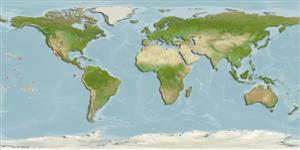Environment: milieu / climate zone / depth range / distribution range
Écologie
marin récifal. Tropical; 32°N -
Eastern Pacific: throughout Gulf of California south to Peru. Recorded in the Galapagos Islands during the 1982-83 El Niño (Ref. 9405).
Taille / Poids / Âge
Maturity: Lm ? range ? - ? cm
Max length : 25.0 cm TL mâle / non sexé; (Ref. 9118); common length : 20.0 cm TL mâle / non sexé; (Ref. 9118)
Description synthétique
Clés d'identification | Morphologie | Morphométrie
Body elongate, moderately compressed, and deep, with a strongly arched dorsal profile; snout prominent; mouth small and sub-terminal; lower jaw enclosed by upper; chin with 5 pores but without barbels; edge of preopercle slightly serrate; lower branch of first gill arch with 6 gill rakers; second dorsal fin very long, with 32 to 33 soft rays; body uniformly dark, from purplish bronze to grayish brown; fins dark or blackish (Ref. 55763).
Adults are secretive nocturnal fish that hide under ledges by day and come out only at night to feed on the epifauna of the substrate. The adults sometimes form large inactive aggregations in caves, but little or no feeding occurs. Schools of juveniles appear only in the summer.
Life cycle and mating behavior
Maturities | Reproduction | Spawnings | Egg(s) | Fecundities | Larves
Chao, L.N., 1995. Sciaenidae. Corvinas, barbiches, bombaches, corvinatas, corvinetas, corvinillas, lambes, pescadillas, roncachos, verrugatos. p. 1427-1518. In W. Fischer, F. Krupp, W. Schneider, C. Sommer, K.E. Carpenter and V. Niem (eds.) Guia FAO para identificacion de especies para los fines de la pesca. Pacifico Centro-oriental. 3 volumes. 1813 p. (Ref. 9118)
Statut dans la liste rouge de l'IUCN (Ref. 130435)
Menace pour l'homme
Harmless
Utilisations par l'homme
Pêcheries: intérêt commercial mineur; Aquarium: Aquariums publics
Outils
Articles particuliers
Télécharger en XML
Sources Internet
Estimates based on models
Preferred temperature (Ref.
123201): 20.6 - 29.1, mean 25.1 °C (based on 236 cells).
Phylogenetic diversity index (Ref.
82804): PD
50 = 0.5078 [Uniqueness, from 0.5 = low to 2.0 = high].
Bayesian length-weight: a=0.00851 (0.00413 - 0.01752), b=3.08 (2.91 - 3.25), in cm total length, based on LWR estimates for this (Sub)family-body shape (Ref.
93245).
Niveau trophique (Ref.
69278): 3.5 ±0.37 se; based on food items.
Résilience (Ref.
120179): Haut, temps minimum de doublement de population inférieur à 15 mois (Preliminary K or Fecundity.).
Fishing Vulnerability (Ref.
59153): Low vulnerability (15 of 100).
Nutrients (Ref.
124155): Calcium = 70.8 [36.4, 114.2] mg/100g; Iron = 0.672 [0.340, 1.125] mg/100g; Protein = 19.5 [18.2, 20.9] %; Omega3 = 0.154 [0.084, 0.231] g/100g; Selenium = 35.3 [21.3, 64.1] μg/100g; VitaminA = 81.1 [27.7, 265.5] μg/100g; Zinc = 1.3 [0.9, 1.8] mg/100g (wet weight);
